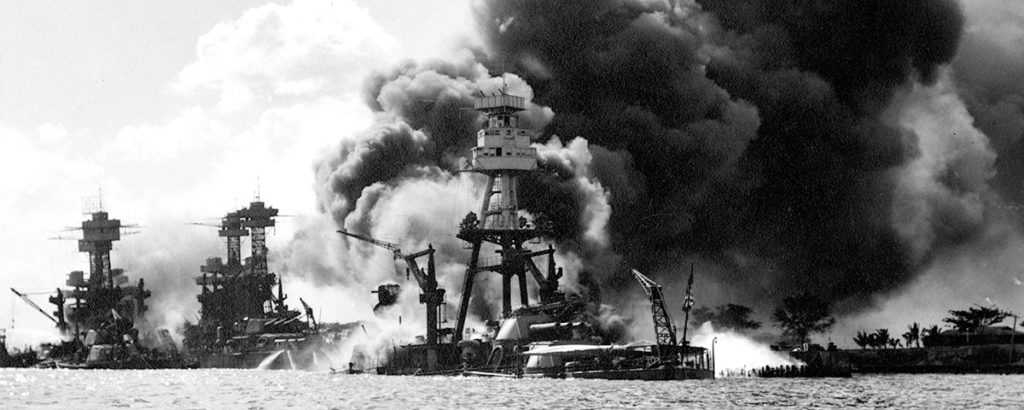On December 7, 1941, United States naval forces at Pearl Harbor awoke to exploding sounds of bombs and gunfire. On that Sunday morning at 7:55 a.m.,350 Japanese aircraft bombed “Battleship Row” on Hawaii’s largest Island. The Imperial Japanese Navy, which had journeyed more than 3,000 miles undetected across the Pacific, launched its surprise attack with the intent of destroying the core of the American Pacific fleet.
The air attack had been launched from Japanese aircraft carriers 250 miles away. In 90 minutes of bombing, Japanese fighter planes sank 21 American naval ships, including eight battleships and two destroyers. In addition, more than 300 American planes were destroyed. In the attack 2,403 American military and civilian lives were lost, nearly half of them resulting from the sinking of the large battleship USS Arizona.
While Americans were surprised by the attack on Pearl Harbor, Japanese aggression in China and Indochina had concerned American political and military leaders for more than two decades. Japan desired to expand its territory and acquire colonies which could supply raw material for its economic expansion. While Europe and America took notice of Japan’s declaration of war with China in 1937, US Congressional leaders remained committed to isolationism or “America First” foreign policy.
Soon after, when Japanese aggression in Nanking, China took the form of massacres and horrible atrocities, President Franklin D. Roosevelt responded with some embargoes. He declared economic sanctions which included extensive curtailment of oil sales to Japan. The Japanese military machine’s greatest need was oil, which came almost wholly from American suppliers. In the summer of 1941, Roosevelt expanded the embargo to include scrap iron, steel and aviation fuel.
Japan, believing that its war with China could not be won without ample supplies of oil, iron, and steel, sent military forces into French Indochina, present day Vietnam, Cambodia, and Laos. Japan easily conquered these regions with the ultimate objective of acquiring the Dutch East Indies, which had huge oil resources. To Japanese military leaders, America stood in the path of its broad plan to expand Japan’s territory. Japan’s military leaders conceived the plan to attack Pearl Harbor with the idea of delivering a serious blow to America so that the Japanese flag could eventually fly over all of Asia.
All wars are horrible, and most– if not all, could have been avoided. Beginning in the later half of the nineteenth century, European nations led by England, France, Italy, Germany and the Netherlands carved up Africa, the Middle East, and parts of Asia as colonies to serve the needs for natural resources. World War I was fought in part to limit aggressive colonization by Germany and Italy. World War II would be fought over the continued desire for territorial expansion by the Germans, Italians and Japanese. The loss of lives in World War II surpassed 50 million, including six million Jews who were murdered by the Nazis.
Twenty years after the signing of the 1918 Armistice that ended World War I, known as the Great War, German troops crossed into Austria and occupied that country. The Western European countries and America wished to avoid another war and allowed Adolf Hitler and his Nazi forces to also invade Czechoslovakia without a reprimand. Sensing that he would be allowed to overrun parts of the European continent uncontested, Hitler ordered an invasion of Poland in 1939. That invasion proved too much for England and France, and they declared war on Germany.
The Isolationist leadership in the United States Senate and America First contingents prevented President Franklin D. Roosevelt from joining England and France in its fights against the Germans, but after 1939, Roosevelt managed to lend support with ships and supplies to the British and French Resistance. In the meantime, Italy and Japan joined Germany to form the Axis Powers. When Germany successfully overran France in early 1941, Japan received approval from German occupied authorities in France to march into French Indochina.
Following the Japanese attack of Pearl Harbor, President Roosevelt went before Congress on December 8, 1942 and declared war against Japan. When Germany and Italy declared war on the United States three days later, America entered World War II.
World War II had many causes. Chief among them were the unresolved geopolitical issues of World War I, the rise of fascism in Italy and Germany, unchecked aggression over decades in Asia by the Japanese, and conflict over colonialism in much of the Third World. World War II in turn, contributed to the Cold War, the Korean War and Vietnam.
World War II also gave rise to the development of missiles by the Germans and the use of atomic bombs by the American military, made possible through new technology and long range bombers. These weapons of mass destruction have made peaceful conflict resolution ever more important.
Global wars will continue to plague us if countries allow evil leaders like Adolf Hitler, Benito Mussolini, and Joseph Stalin to exercise political and military power. Over much of the twentieth century rational government leaders have sought to create entities like the League of Nations, United Nations and NATO as a means to deter conflict among countries. The success of these and other international organizations have the potential to prevent conflicts and promote peaceful negotiations and treaties which can lessen the possibility of another World War.
Pearl Harbor: Why It Happened










There are two corrections needed. First, Oahu is the most populated island, but it is not the largest island. And second, Roosevelt declared war on December 8, 1941, not 1942.